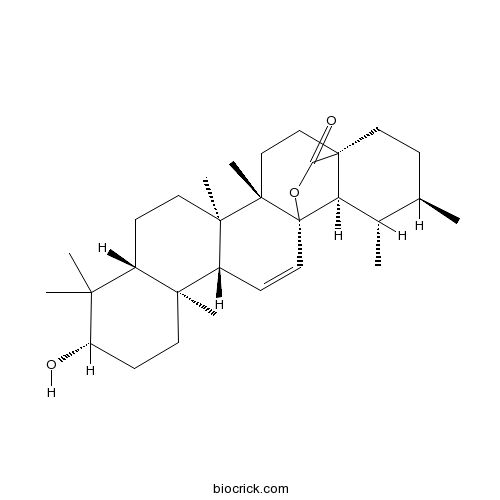3-Hydroxy-11-ursen-28,13-olideCAS# 35959-05-8 |

Quality Control & MSDS
3D structure
Package In Stock
Number of papers citing our products

| Cas No. | 35959-05-8 | SDF | Download SDF |
| PubChem ID | 21606663 | Appearance | Powder |
| Formula | C30H46O3 | M.Wt | 454.7 |
| Type of Compound | Triterpenoids | Storage | Desiccate at -20°C |
| Solubility | Soluble in Chloroform,Dichloromethane,Ethyl Acetate,DMSO,Acetone,etc. | ||
| Chemical Name | (1S,4S,5R,8R,10S,13S,14R,17S,18R,19S,20R)-10-hydroxy-4,5,9,9,13,19,20-heptamethyl-24-oxahexacyclo[15.5.2.01,18.04,17.05,14.08,13]tetracos-15-en-23-one | ||
| SMILES | CC1CCC23CCC4(C5(CCC6C(C(CCC6(C5C=CC4(C2C1C)OC3=O)C)O)(C)C)C)C | ||
| Standard InChIKey | UVBLDLGZDSGCSN-RUOWOPRNSA-N | ||
| Standard InChI | InChI=1S/C30H46O3/c1-18-8-14-29-17-16-28(7)27(6)13-9-20-25(3,4)22(31)11-12-26(20,5)21(27)10-15-30(28,33-24(29)32)23(29)19(18)2/h10,15,18-23,31H,8-9,11-14,16-17H2,1-7H3/t18-,19+,20+,21-,22+,23-,26+,27-,28+,29+,30+/m1/s1 | ||
| General tips | For obtaining a higher solubility , please warm the tube at 37 ℃ and shake it in the ultrasonic bath for a while.Stock solution can be stored below -20℃ for several months. We recommend that you prepare and use the solution on the same day. However, if the test schedule requires, the stock solutions can be prepared in advance, and the stock solution must be sealed and stored below -20℃. In general, the stock solution can be kept for several months. Before use, we recommend that you leave the vial at room temperature for at least an hour before opening it. |
||
| About Packaging | 1. The packaging of the product may be reversed during transportation, cause the high purity compounds to adhere to the neck or cap of the vial.Take the vail out of its packaging and shake gently until the compounds fall to the bottom of the vial. 2. For liquid products, please centrifuge at 500xg to gather the liquid to the bottom of the vial. 3. Try to avoid loss or contamination during the experiment. |
||
| Shipping Condition | Packaging according to customer requirements(5mg, 10mg, 20mg and more). Ship via FedEx, DHL, UPS, EMS or other couriers with RT, or blue ice upon request. | ||
| Description | 1. 3β-Hydroxy-urs-11-en-28,13β-olide exhibits weak-moderate antiproliferative activity against the A2780 human ovarian cancer cell line. 2. 3β-Hydroxy-urs-11-en-13β,28-olide shows a potent concentration-independent cytoprotective effect against CCl4-induced injury on human hepatoma cell line relative to silymarin as a reference standard. |

3-Hydroxy-11-ursen-28,13-olide Dilution Calculator

3-Hydroxy-11-ursen-28,13-olide Molarity Calculator
| 1 mg | 5 mg | 10 mg | 20 mg | 25 mg | |
| 1 mM | 2.1993 mL | 10.9963 mL | 21.9925 mL | 43.985 mL | 54.9813 mL |
| 5 mM | 0.4399 mL | 2.1993 mL | 4.3985 mL | 8.797 mL | 10.9963 mL |
| 10 mM | 0.2199 mL | 1.0996 mL | 2.1993 mL | 4.3985 mL | 5.4981 mL |
| 50 mM | 0.044 mL | 0.2199 mL | 0.4399 mL | 0.8797 mL | 1.0996 mL |
| 100 mM | 0.022 mL | 0.11 mL | 0.2199 mL | 0.4399 mL | 0.5498 mL |
| * Note: If you are in the process of experiment, it's necessary to make the dilution ratios of the samples. The dilution data above is only for reference. Normally, it's can get a better solubility within lower of Concentrations. | |||||

Calcutta University

University of Minnesota

University of Maryland School of Medicine

University of Illinois at Chicago

The Ohio State University

University of Zurich

Harvard University

Colorado State University

Auburn University

Yale University

Worcester Polytechnic Institute

Washington State University

Stanford University

University of Leipzig

Universidade da Beira Interior

The Institute of Cancer Research

Heidelberg University

University of Amsterdam

University of Auckland

TsingHua University

The University of Michigan

Miami University

DRURY University

Jilin University

Fudan University

Wuhan University

Sun Yat-sen University

Universite de Paris

Deemed University

Auckland University

The University of Tokyo

Korea University
- Anchustrigosine
Catalog No.:BCC8185
CAS No.:
- Pteroside D
Catalog No.:BCN5311
CAS No.:35943-38-5
- Triciribine
Catalog No.:BCC3872
CAS No.:35943-35-2
- Pterosin C
Catalog No.:BCN7104
CAS No.:35938-43-3
- Vicenin -1
Catalog No.:BCN3012
CAS No.:35927-38-9
- NECA
Catalog No.:BCC5804
CAS No.:35920-39-9
- Pterosin A
Catalog No.:BCN8147
CAS No.:35910-16-8
- Pteroside A
Catalog No.:BCN8146
CAS No.:35910-15-7
- 3,3-Dimethoxy-5α-androstan-17-one
Catalog No.:BCC8594
CAS No.:3591-19-3
- Onjisaponin B
Catalog No.:BCN2741
CAS No.:35906-36-6
- Boc-His(Tos)-OH
Catalog No.:BCC3402
CAS No.:35899-43-5
- Ligustroside
Catalog No.:BCN5310
CAS No.:35897-92-8
- 3-Acetoxy-11-ursen-28,13-olide
Catalog No.:BCN5313
CAS No.:35959-08-1
- Inotodiol
Catalog No.:BCN3331
CAS No.:35963-37-2
- Triptotin F
Catalog No.:BCN3482
CAS No.:359630-36-7
- Pterosin G
Catalog No.:BCN8148
CAS No.:35964-50-2
- 3,6-Ditigloyloxynortropane
Catalog No.:BCN1877
CAS No.:359723-70-9
- [Ala17]-MCH
Catalog No.:BCC6024
CAS No.:359784-84-2
- Glycodeoxycholic acid
Catalog No.:BCN7250
CAS No.:360-65-6
- Nandrolone decanoate
Catalog No.:BCC9087
CAS No.:360-70-3
- 2',4'-Dihydroxy-6'-methoxyacetophenone
Catalog No.:BCN5314
CAS No.:3602-54-8
- Ecdysone
Catalog No.:BCN2629
CAS No.:3604-87-3
- Diepiserratenediol
Catalog No.:BCN7433
CAS No.:3604-92-0
- Alpinetin
Catalog No.:BCN5315
CAS No.:36052-37-6
Antibacterial and Synergistic Activity of Pentacyclic Triterpenoids Isolated from Alstonia scholaris.[Pubmed:26821000]
Molecules. 2016 Jan 25;21(2):139.
(1) BACKGROUND: Alstonia scholaris (Apocynaceae) is an important medicinal plant that has been historically used in "Dai" ethnopharmacy to treat infectious diseases in China. Although various pharmacological activities have been reported, the antimicrobial constitutes of A. scholaris have not yet been identified. The objective of this study is to evaluate the antibacterial constitutes from the leaf extract of A. scholaris and to assess the synergistic effects of isolated compounds with antibiotics against bacterial pathogens.; (2) METHODS: The chemical constitutes isolated from the leaf extract of A. scholaris were structurally identified by NMR. The antibacterial and synergistic effect of compounds was assessed by calculating the minimal inhibitory concentration (MIC), checkerboard dilution test, and time-kill assay.; (3) RESULTS: Six pentacyclic triterpenoids were structurally identified as (1) lupeol, (2) betulin, (3) 3-Hydroxy-11-ursen-28,13-olide, (4) betulinic acid, (5) oleanolic acid and (6) ursolic acid. Both oleanolic and ursolic acid showed antibacterial activity but were limited to Gram-positive bacteria. Ursolic acid showed a synergistic effect with ampicillin and tetracycline against both Bacillus cereus and S. aureus.; (4) CONCLUSION: These findings reflect that pentacyclic triterpenoids are the antibacterial chemicals in A. scholaris. The ability of ursolic acid to enhance the activity of antibiotics can constitute a valuable group of therapeutic agents in the future.


